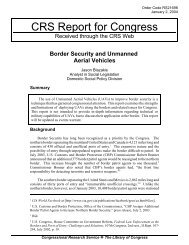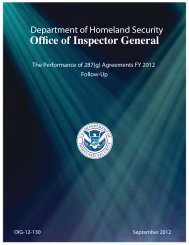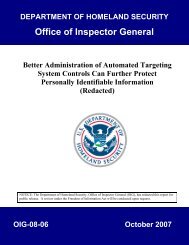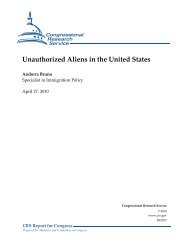Asylum and "Credible Fear" Issues in U.S. Immigration Policy
Asylum and "Credible Fear" Issues in U.S. Immigration Policy
Asylum and "Credible Fear" Issues in U.S. Immigration Policy
Create successful ePaper yourself
Turn your PDF publications into a flip-book with our unique Google optimized e-Paper software.
<strong>Asylum</strong> <strong>and</strong> “<strong>Credible</strong> Fear” <strong>Issues</strong> <strong>in</strong> U.S. <strong>Immigration</strong> <strong>Policy</strong>Mexico 50<strong>Asylum</strong> seekers from Mexico reached a 13-year high po<strong>in</strong>t <strong>in</strong> the late 1990s. As Figure 12 shows,defensive claims reached 18,389 <strong>and</strong> affirmative claims hit 13,663 <strong>in</strong> FY1997. Mexicanaffirmative cases evidenced a moderate surge <strong>in</strong> FY2001 (8,747) <strong>and</strong> FY2002 (8,977), but theoverall trend l<strong>in</strong>e has decl<strong>in</strong>ed by 89.8% from FY1997 through FY2009. The number of defensiveclaims has decreased as well, by 84.7% from FY1997 through FY2009. The 13-year average was4,258 for affirmative claims <strong>and</strong> 5,797 for defensive claims. Mexican “credible fear” claimsdur<strong>in</strong>g expedited removal have risen from 107 <strong>in</strong> FY2005 to 338 <strong>in</strong> FY2009, but they have notreach the numbers that the PRC <strong>and</strong> El Salvador claims have.Figure 12. <strong>Asylum</strong> Seekers from Mexico20 Thous<strong>and</strong>s <strong>Credible</strong> Fear Affirmative Defensive151210501997199819992000200120022003200420052006200720082009Fiscal YearSource: CRS presentation of data from the USCIS Directorate of Refugee, <strong>Asylum</strong>, <strong>and</strong> InternationalOperations <strong>and</strong> the Office of Plann<strong>in</strong>g, Analysis <strong>and</strong> Technology <strong>in</strong> the Executive Office for <strong>Immigration</strong> Review.Notes: Data represent cases not <strong>in</strong>dividuals. The Y axis is larger—spann<strong>in</strong>g to 20,000—<strong>in</strong> this figure than <strong>in</strong> thecomparable figures, which have the Y axis set at 12,000.50 For background on country conditions, see CRS Report RL32724, Mexico: <strong>Issues</strong> for Congress, by Clare Rib<strong>and</strong>oSeelke.Congressional Research Service 21












